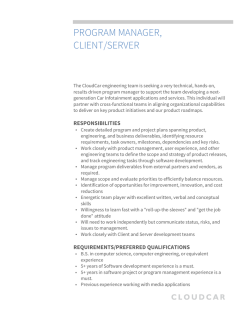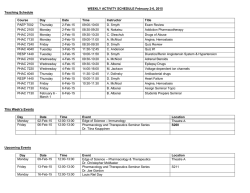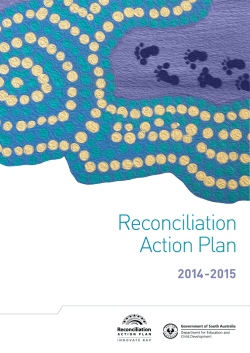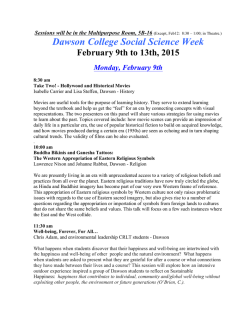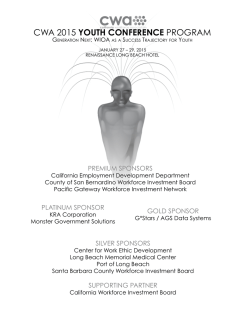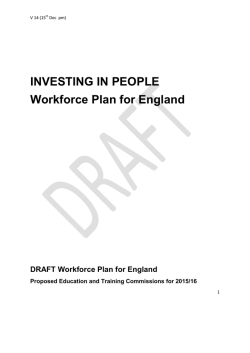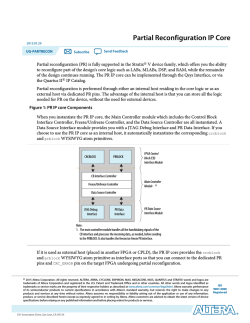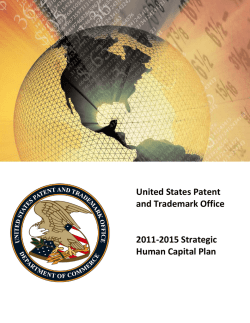
(NMAHS) Strategic Plan 2012-2015
North Metropolitan Health Service Strategic Plan: 2012 - 2015 The NMAHS acknowledges the traditional owners of the land, the Noongar people. We pay our respects to the elders past and present and recognise the continuing cultural and spiritual practices of the Noongar people. Contents 1 Introduction from the Chief Executive 2 Background Information about North Metropolitan Area Health Service 3 Purpose of the Plan 4 Our Vision, Mission and Values 5 Our Achievements 6 Our Challenges and Opportunities 7 Our Strategic Priorities 2012-2015 a. Strategic Priority 1 b. Strategic Priority 2 c. Strategic Priority 3 d. Strategic Priority 4 e. Strategic Priority 5 8 Governance 9 Enabling Strategies 10 Implementation Page 3 of 44 Introduction from the Chief Executive The release of the Strategic Plan 2012 - 2015 marks a pivotal moment in the history of the North Metropolitan Area Health Service (NMAHS). As a relatively young service, the intention is to unite the hospitals and community services that comprise NMAHS with a common vision and approach to improve the wellbeing of those we care for as we mature through this strategic plan. Rising demand for services and the other challenges we face necessitate an innovative approach to health care delivery. Building on our achievements so far, this Strategic Plan will channel our focus and attention to make the necessary whole-ofsystem improvements to ensure our patients receive safe, high quality, culturally secure care in an environment that delivers a positive patient experience. We are committed to continuous improvement and strong relationships amongst our staff, services and other stakeholders including WA Health, patients, carers and primary care providers. Essential to our journey is the commitment of our staff in an evolving environment. We recognise the valuable team we have and the Strategic Plan outlines our intent to complement our team’s skills and diversity through attraction, retention and education strategies in the coming years. This Strategic Plan outlines how we will shape the future so our community can live longer, healthier, more fulfilling lives. It is ambitious and, through implementation, will lay the foundations for a strong, sustainable future. Dr D J Russell-Weisz Page 4 of 44 North Metropolitan Area Health Service The NMAHS is a leader in delivering timely access to high quality health care to Western Australians and is the major provider of health services for the people in the north and eastern regions of Perth. The NMAHS is the largest health service in the metropolitan area with a 3,000 square kilometre catchment, including 17 local governments, and in which almost 1 million people – over 40 percent of the State’s population – reside. Our Health Service provides a comprehensive range of health services within a number of locations including hospital, home and community based settings. The Health Service manages over 1,840 beds through three tertiary hospitals and three outer metropolitan hospitals, oversees the provision of contracted public health care from the privately operated Joondalup Health Campus and oversees the delivery of pathology and dental services across the State. A range of state-wide, highly specialised multi-disciplinary services are also offered from several hospital and clinic sites. In addition to providing clinical care, NMAHS also has a key role in research and education to ensure world-class evidence based health care and community capacity building interventions can continue to be delivered into the future. NMAHS comprises the NMAHS Mental Health Program (including Graylands Hospital), NMAHS Public Health and Ambulatory Care, PathWest, Sir Charles Gairdner Group, Swan Kalamunda Health Service and Women and Newborn Health Service. NMAHS manages the contract for the delivery of public health care at Joondalup Health Campus under a Public Private Partnership and manages the Queen Elizabeth II Medical Centre site (QEIIMC), a delegated responsibility of the QEIIMC Trust. NMAHS employs over 8,500 staff across our services, is aided by the support from our volunteers and assists with the teaching and training of students from a range of disciplines. On any average day, NMAHS (including contracted services): • • • • • • • • • • • Cares for 1,659 people in its hospitals Performs 132 elective surgery procedures Delivers 29 babies through its hospitals and community midwifery program Provides radiotherapy for 224 people Sees 5,066 people in its outpatient clinics Sees 519 people in its Emergency Departments Has 590 people enrolled in its community mental health and rehabilitation programmes Has 87 people enrolled in hospital in the home services Has 2,022 people attending Dental Health Services Conducts 270 community physiotherapy classes per week across the metropolitan area Spends $5.1 million per day in delivering its services Page 5 of 44 This Strategic Plan This Strategic Plan sets a clear direction and focus for NMAHS from 2012 to 2015. It sets the high level strategic agenda and is enabled by the delivery of workforce, financial, Information Communication Technology (ICT) and infrastructure programs across NMAHS and the wider WA Health system. As a health service, it is critical that efforts are focussed on strategies that will deliver the best clinical outcomes for our patients and the best working environment for our staff. As demand for health services is ever increasing, NMAHS must remain responsive through clinical process redesign and continuous improvement. For this reason, the Strategic Plan is underpinned by evidence based practice. This Strategic Plan details our mission, vision and values that guide the day to day work of NMAHS and provide a focus for longer term planning, as outlined later in the document. Importantly, this Strategic Plan communicates to our key stakeholders where our efforts will be invested over the coming three years. This Strategic Plan sits within the wider planning context of WA Health, and in particular has been guided by the following documents: 1. WA Health Strategic Intent The NMAHS Strategic Plan aligns directly to WA Health’s Strategic Intent 20102015, which focuses on care being provided across four pillars: 1. Caring for individuals and the community 2. Caring for those who need it most 3. Making best use of funds and resources 4. Supporting our team. 2. WA Health Clinical Services Framework 2010-2020 (CSF) The CSF is the principal clinical planning document for WA Health. The CSF describes the high level service profile for hospital and non-hospital based services planned across NMAHS until 2020, and is based on current demographic data and projections of future service needs. Page 6 of 44 Our Vision, Mission and Values Our Vision: Excellence in health care for our community. Our Mission: To improve, promote and protect the health of Western Australians within the NMAHS catchment by: • • • • Caring for individuals and the community Caring for those who need it most Making the best use of funds and resources Supporting our team. Our Values: Care by demonstrating commitment and consideration to others as we work. Respect for each other, our clients and their families, carers and the community by preserving individual dignity and supporting the right of everyone to make choices. Excellence by providing high quality, accessible, integrated and safe health care to the community. We believe in working in partnership with clients to improve their health. Integrity by providing quality services and advice for the common good and having honest dealings and communication with other people. Teamwork by valuing the contribution of the team, working safely and cooperatively and communicating effectively with the team. Leadership by communicating NMAHS’s vision, taking responsibility for our actions and decisions and displaying trust in our colleagues. Page 7 of 44 Our Achievements Over the past three years NMAHS has achieved a number of significant improvements in the way we deliver care to our community whilst ensuring a sustainable approach to the utilisation of resources. These achievements provide a solid base for continuing our service improvements over the next three years and include: Elective Surgery Capacity for elective surgery has been increased with an expanded Surgicentre, including a Pre-Admission Clinic and a Central Sterilising Support Department at Osborne Park Hospital (OPH). There has been an increase in the referral of medically suitable patients from tertiary to secondary sites for elective procedures, more effective waitlist management and increased recruitment of salaried surgeons. In addition, extended surgery sessions have been commenced and an accelerated rehabilitation program implemented post elective orthopaedic surgery at SCGH and OPH to improve patient flow. NMAHS is committed to further improvement to meet the National Elective Surgery Targets (NEST) which requires 95 per cent of Category 1 and 2 patients to be treated within clinically recommended times. Emergency Care The Four Hour Rule program which aims to admit, discharge or transfer 85% of patients who attend an emergency department within four hours has been progressively introduced at NMAHS sites since 2009. All sites have made significant gains in refining service provision to achieve this target as evidenced below, in an environment of significant increased demand. Reforms are now continuing at all sites in line with NMAHS commitment to achieving the National Emergency Access Target (NEAT) of 90% of patients admitted or discharged within four hours by 2015. Percentage of patients admitted, discharged or transferred within four hours Site Baseline Current Performance (March Quarter 2012) Current Target Sir Charles Gairdner Hospital 44% 70.9% 85% Swan District Hospital 67% 79.9% 85% Joondalup Health Campus 67% 67.5% 85% King Edward Memorial Hospital 89% 89.0% 85% Additionally, Joondalup Health Campus (JHC) Emergency Department capacity has doubled as part of the site’s redevelopment and Swan District Hospital’s Emergency Department upgrade is nearing completion. Meeting Demand through New Infrastructure The expansion of the Neonatal Critical Care Unit and Maternal Foetal Assessment Unit at King Edward Memorial Hospital is complete. This follows the opening of the Mother and Baby Unit in June 2007. Joondalup Health Campus has opened a new 55-bed public ward block, a new emergency department and an expanded Mental Health Unit as part of its continued redevelopment. Page 8 of 44 Sir Charles Gairdner Hospital has expanded its Intensive Care Unit, opened a new Geriatric Evaluation and Management Unit, new Nursing Observation Specials Area and an expanded Interventional Neuroradiology suite. Establishment of the Gairdner Rehabilitation Unit and the recruitment of a Rehabilitation Physician providing enhanced rehabilitation services for patients requiring slow stream rehabilitation has also occurred. New public health facilities include purpose fit clinics for the Humanitarian Entrant Health Service and the WA Tuberculosis Control Program. Reduced Dependency on Hospital Care Access to flexible home care has improved across NMAHS with increased staffing for the improved coordination of care for complex patients to reduce avoidable emergency department and hospital admissions. There has also been continued expansion of NMAHS inhome services through the Rehabilitation in the Home (RITH), Hospital in the Home (HITH), Rehabilitation and Aged Care Intervention Liaison Service (RAILS) at OPH and ongoing access to Hospital at the Home (HATH). Services in the community include the Early Supported Discharge Stroke Program, the Community Physiotherapy Service, the Women and Newborn Drug and Alcohol Service’s satellite clinic at Bandyup Prison and Breastscreen mobile screening and health promotion initiatives. Access to community mental health services has been further enhanced through the development of extended hours (0830 to 2200) Assessment and Treatment teams. Innovative Practices to Enable Care Closer to Home NMAHS has embraced a number of practices to facilitate care being provided closer to home, including: • Wounds West education online • Telehealth • New emergency department and inpatient unit at JHC • Stroke unit at SDH • Expanded emergency department at SDH Aboriginal Health is Everyone’s Business Aboriginal Health is a key area of achievement that NMAHS is keen to build upon. This requires collaborative partnerships between the Aboriginal and non Aboriginal NMAHS key stakeholders to ensure that when Aboriginal people utilise services within the NMAHS, their cultural needs are recognised and met. The Aboriginal Health Unit (AHU) was established as a part of the NMAHS Public Health Unit in 2008. The role of the AHU is to develop and implement programs specific to the 12,000 Aboriginal people living in the north metropolitan region of Perth. The AHU strives to be a best practice unit which provides a supportive environment for its workforce to deliver effective and secure services to and for the local Aboriginal community. It consists of local Aboriginal people with strong community connections and knowledge. Page 9 of 44 An Aboriginal Maternity Services Support Unit has been established at the Women and Newborn Health Service with the key goals of building capacity and sustainability within the Aboriginal Community Controlled Health Sector and building/fostering partnerships between maternal and child health service providers, whilst improving the cultural competence/security of main stream health services. The overall aim is to improve access to maternal and child health services for all Aboriginal women and families to close the gap in these important health outcomes. Specialist Aboriginal Mental Health Services were implemented in 2011 to enhance access to specialist mental health services through a co-consultancy model of care promoting cultural competency and security of mainstream mental health services. Page 10 of 44 Our Challenges and Opportunities Health care providers throughout Australia and other developed countries are facing many pressures and challenges as demand for services increase. NMAHS is no different, and as implementation of this Strategic Plan progresses, many challenges will be encountered. However, where there are challenges, there are also great opportunities to strengthen and build on the work that is already underway, and in doing so ensure the services provided are relevant for the future needs of our community. Challenges National Challenges The National Health Reform Report identified a number of challenges applicable to all health services: • • • • Ageing population Growing demand Increasing health care costs Increasing prevalence of chronic disease and co-morbidities NMAHS Key Challenges In addition to the above challenges, NMAHS faces a number of specific challenges in delivering services to its community. • • • • Population Distribution There are considerable demands on health services in the growing northern and eastern corridors of Perth. Infrastructure and workforce are key factors in meeting the growing needs of our community. Workforce Capacity and Skill Development Workforce pressures are already being felt across our health service and will increase with the impact of infrastructure and clinical reform and increased demand for services. There is an urgent need at a macro and micro level to become more effective at retaining the skills of our existing workforce and also continuing to attract new staff with the right skill set. Aboriginal Health NMAHS aims to achieve equity in access to health services for Aboriginal people in order to improve their health outcomes and life expectancy. Financial Sustainability Cost pressures continue to rise in health with 24% of the State budget spent on health, or almost $2,500 for every person each year in WA. Strong strategies are necessary to improve financial sustainability, including providing care closer to home and increasing primary health interventions and community care to reduce demand for expensive hospital services. Page 11 of 44 • • Clinical Service Reform There is a requirement for the development of new services and the changing requirements of existing services to match the CSF and to ensure models of care are based on evidence based services targetted to priority population needs. Staff Engagement NMAHS recognises there is still opportunity to engage with our staff to ensure that our service mix and delivery models are viable. Engagement, leadership and accountability with our staff at all levels can bring sustainable improvements in both productivity and quality of service. Opportunities • • • • • • • National Health Reform Agenda In response to the ongoing growth in demand, the National Health Reform Agenda will see the Commonwealth Government increase its contribution to the funding of our public hospitals in the years ahead. The focus of this reform agenda is to ensure sustainability of our health and hospital services. This offers an exciting opportunity to improve performance for the best patient outcomes. Establishment of Governing Councils Under the national health reforms, the NMAHS will become a Local Health Network, with a Governing Council of community members and clinicians representing a broad range of interests, skills and experience. A key role of Governing Council members will be engaging with community members to ensure their needs and concerns are reflected in service planning and performance evaluation. Infrastructure Programme The infrastructure programme has a broad inpatient and non-inpatient focus including hospital and non-inpatient infrastructure to ensure that wherever possible seamless, patient focussed care is provided closer to home. Activity Based Funding/Activity Based Management (ABF/ABM) The ABF/ABM programme will integrate the key components of health service planning, funding and delivery to improve accountability and transparency to the community and our key stakeholders. Community Engagement To ensure all services are patient focussed, community engagement offers an opportunity for community involvement in decision making about the delivery of health services. Redevelopment Programme QEIIMC and the New Children’s Hospital The collaboration of children’s services with existing adult services on the QEIIMC provides a unique opportunity to enhance care pathways for adolescents and young people as they transition to adult care. Mental Health Commission Joint planning with the Mental Health Commission provides opportunities for enhanced collaboration with the community managed sector and primary care. Page 12 of 44 Our Strategic Priorities 2012 – 2015 NMAHS has identified five strategic priority areas that provide the focus to enable us to deliver on our commitments towards achieving our vision over the next three years. The strategic priorities build on the organisation’s achievements to date and reflect our response to the challenges and opportunities that have been previously described. Strategic goals have been developed for each Strategic Priority, and for each Goal actions detail how and when these Goals will be achieved within the life of this Plan. The Strategic Priorities and Goals build on WA Health’s four Strategic Intent Pillars and the pillars of our NMAHS Mission: • • • • Caring for individuals and the community Caring for those who need it most Making best use of funds and resources Supporting our team. The alignment of our Strategic Priorities with these Pillars is represented in the table on the following page: Our Strategic Priorities for 2012-2015 are: • • • • • Clinical reform and reconfiguration Quality and safety Community and partnerships People and workplace culture Resourcing for sustainability. Page 13 of 44 1. Clinical Reform and Reconfiguration 2. Quality and Safety ●● ●● 1.1 Incorporate clinical innovation and best practice into delivery of care 2.1 Deliver high quality, reliable and safe health care to every patient, every time, everywhere 1.2 Deliver services closer to home where appropriate 2.2 Achieve or exceed all required standards of service and care Strategic Goals Strategic Goals Strategic Strategic Priorities Priorities Our Strategic Priorities 2012 – 2015 1.3 Enhance access to services 1.4 Provide seamless service delivery within NMAHS and integration with other AHSs Page 14 of 44 3. Community and Partnerships 4. People and Workplace Culture 5. Resourcing for Sustainability ●● ●●● ●● 3.1 Engage with our community 4.1 Build and maintain a flexible, motivated and skilled workforce to meet current and future needs 5.1 Ensure optimal use of all resources across the NMAHS 4.2 Ensure a healthy and safe workplace environment and culture where staff are motivated and treated fairly and with respect 5.2 Manage financial resources to achieve a sustainable financial position 2.3 Deliver care in accordance with quality, standardised evidence based practice 3.2 Deliver well coordinated, need-specific and culturally sensitive health services to indigenous Australians 4.3 Develop the leadership and management capacity and performance of our staff 5.3 Deliver our infrastructure programme 2.4 Ensure patient safety through the management of clinical risks 3.3 Work innovatively with the community and partners to reduce dependency on hospital care 4.4 Enhance and maintain culture and processes to support ethical and professional conduct by all staff 5.4 ICT requirements to support service delivery across NMAHS sites are identified and prioritised. 3.4 Work innovatively with all partners to ensure seamless care, close to home 4.5 Strengthen teaching, training and research with a focus on improved health outcomes 5.5 Plan for future physical infrastructure requirements ● caring for individuals and the community ● caring for those who need it most ● making best use of funds and resources ● supporting our team Strategic Priority 1 – Clinical Reform and Reconfiguration Strategic Goal 1.1: Incorporate clinical innovation and best practice into delivery of care Outcomes Deliverables Responsibility Services are provided in accordance with agreed models of care. • Area wide specialty framework developed. ED CP&R • Specialty specific service delivery models are developed and role delineations in place. ED CP&R • Review workforce implications of models of care. ED WF • Innovation and Improvement Unit established at SCGH. ED SCGG • Review requirement for Area-wide Innovation and Improvement Unit. ED SCGG • Continual improvement philosophy and approach established across the AHS, as evidenced through the implementation of continuous improvement strategies. ED SQ&P • Process in place to identify ongoing priority areas for innovation and improvement projects. DSD Clinical innovation and improvement is evident across the organisation. Page 15 of 44 Strategic Goal 1.2: Deliver services closer to home where appropriate Outcomes Deliverables Responsibility Infrastructure and resources are in place to support the reconfiguration of services. • Funded business plan to support transition / reconfiguration. DSD Reconfiguration achieved in accordance with the CSF. • Physical infrastructure capacity available in accordance with CSF. ED CP&R • Activity shifted from tertiary hospitals to JHC and SDH. ED CM / ED SKHS • Bed day savings achieved in accordance with the CSF and demand modelling. DSD There is clear and timely communication between hospitals, GPs and non-inpatient services. • Standardised GP referral process established. ED MS • Standardised discharge letter for GPs established. ED MS Patients access services in accordance with the CSF and models of care. • Comprehensive community education programme regarding reconfiguration of services across NMAHS. M COMM Staff and patients in rural and remote areas have consistent and reliable access to experts. • NMAHS Telehealth Strategic Plan is developed and implemented. ED MS • Strategies for up skilling regional staff implemented. ED MS Page 16 of 44 Strategic Goal 1.3: Enhance access to services Outcomes Deliverables Responsibility Gaps in service access are identified promptly. • System in place to monitor access to services and identify priority areas for action. ED CP&R Criteria for access to NMAHS services are clearly documented. • Access criteria developed for two services per annum. ED MS • Needs assessment for adult eating disorders services completed collaboratively with CAHS and Centre for Clinical Interventions (CCI). ED SCGG • Adult Rehabilitation Services • Options developed for delivering adult rehabilitation services across NMAHS. ED CP&R • Aged Care Services • Plan developed for provision of the required health services for the aged population. ED CP&R • Breastscreen and other screening services • Options developed for delivering screening services across the NMAHS. ED WNHS • Disability Access & Inclusion Plan implemented. • Disability Access & Inclusion Plan implemented. ED PHAC • Elective Surgery • Elective access program implemented. ED SCGG • Mental Health Services • Options developed for delivering adult and older adult mental health services for the Joondalup catchment. ED MHS • Programs developed in collaboration with the Department of Corrective Services to increase access to specialist services for mentally ill offenders. ED MHS • Development and implementation of a specialist metropolitan youth mental health services program. ED MHS Patients have improved access to services, including: • Adult Eating Disorder Services Page 17 of 44 ED MHS ED CP&R Outcomes Deliverables Responsibility • Neuroscience Services. • Review of requirements for State Neurosciences Centre completed and action plan developed. ED CP&R • Oral Health Care • Submission funding for Oral Health for eligible patients. ED PHAC • Outpatient Services • New model(s) for outpatients delivery established across the NMAHS. ED SCGG • Consistent process in place for outpatient referrals across the NMAHS based on acuity and service level requirement. ED SCGG • Elective access program in place. ED SCGG • Strategies implemented to improve access to Youth Mental Health Service ED MHS • Strategies implemented to improve access to adolescent and young adult cancer services. ED SCGG • Youth Health Services Page 18 of 44 Strategic Goal 1.4: Provide seamless service delivery within NMAHS and integration with other AHSs Outcomes Deliverables Responsibility Adolescents and young adults transition smoothly from CAHS to NMAHS services. • Transition processes agreed with CAHS and implemented. ED SCGG Optimise the delivery of services for country patients attending NMAHS. • Service delivery models incorporate the needs of country patients in the metro services. ED CP&R • MOU (Memorandum of Understanding) established with WACHS. ED CP&R • MOUs established with all AHSs (Area Health Services) for those services that are cross-boundary. All Services provided across AHS boundaries are well coordinated. Page 19 of 44 Strategic Priority 2 – Quality and Safety Strategic Goal 2.1: Deliver high quality, reliable and safe health care to every patient, every time, everywhere Outcomes Deliverables Safety and quality standards are met and maintained across the NMAHS. • Annual Safety & Quality Performance Reports developed for NMAHS. • Area-wide Quality Improvement Audit on at least two topics each year. Patients presenting at NMAHS Emergency Departments are assessed and admitted, discharged or transferred within target time periods. Clinical leaders promote and facilitate continuous improvement. NMAHS buildings and facilities are safe and fit for purpose. Page 20 of 44 Responsibility ED SQ&P ED SQ&P • Annual NMAHS Safety & Quality Operational Plan developed. ED SQ&P • Achieve key targets for safety & quality. All • Four Hour Rule targets achieved at SCGH, SDH, JHC and KEMH. - SCGH ED SCGG - SDH ED SKHS - JHC ED CM - KEMH ED WNHS • Evidence Based Leadership framework established at: - NMAHS (AEG & Area Functions) DSD - SCGG ED SCGG - SKHS ED SKHS - PHAC ED PHAC - Area Mental Health Service ED AMHS - WNHS ED WNHS • Priority areas within the Facilities Maintenance Plan are addressed. ED FM Strategic Goal 2.2: Achieve or exceed all required standards of service and care Outcomes Deliverables Responsibility NMAHS sites / services maintain accreditation status with relevant organisations. • ACHS accreditation maintained by NMAHS member sites and services. ED SCGG ED SKHS ED WNHS ED MH ED PHAC - Public Health & Ambulatory Care achieve ACHS accreditation status by 2014. National Safety and Quality Standards are met and maintained across the NMAHS. Page 21 of 44 • NATA accreditation maintained by PathWest. ED PW • NMAHS hospitals achieve accreditation against the new National Safety and Quality Health Service Standards, to be introduced in 2013. ED SCGG ED SKHS ED WNHS ED MH • Area-wide Quality Improvement Audit on two topics each year. ED SQ&P Strategic Goal 2.3: Deliver care in accordance with quality, standardised evidence based practice Outcomes Deliverables Services across the NMAHS and statewide services managed by the NMAHS, are provided in line with evidence based practice. • Page 22 of 44 Area wide framework established for incorporating evidence into clinical practice. Responsibility ED SKHS • Processes established for incorporating evidence into clinical policies, guidelines and pathways. ED SKHS • Priority areas for implementing consistent evidence based practice identified. ED SKHS • At least one evidence based clinical guideline developed and implemented each year. ED SKHS Strategic Goal 2.4: Ensure patient safety through the management of clinical risks Outcomes Deliverables Responsibility There is a reduction in preventable clinical incidents. • SQuIRe PLUS Program implemented and targets achieved in the areas of: ED SQ&P - Clinical Deterioration - Clinical Handover - Surgical Safety Checklist - Falls - Medication Reconciliation - Acute Myocardial Infarction compliance - Pressure Ulcers - Hand Hygiene - Central Venous Catheter related Blood Stream Infections - Surgical Site Infections - Venous Thromboembolism prophylaxis Data is collected, analysed and used to identify clinical risks and improve patient safety. Patients affected by adverse events are provided with prompt, accurate and empathetic communication. Page 23 of 44 • An electronic clinical incident reporting and management system is implemented across NMAHS sites and services. ED SQ&P • Clinical incident data is used to identify and address clinical risks. ED SQ&P • WA Hospital-Acquired Infection (HAI) Surveillance data is used to identify and address patient safety issues and trends. ED SQ&P Process of Open Disclosure and transparent communication established at all NMAHS sites and services. ED SQ&P Strategic Priority 3 – Community and Partnerships Strategic Goal 3.1: Engage with our community Outcomes Deliverables Responsibility Members of the community are involved in planning, developing and reviewing services provided by the NMAHS. • NMAHS community engagement plan developed and implemented. ED PHAC • CAC Terms of Reference and processes reviewed. ED SQ&P • Community representation established on key NMAHS strategic and operational groups. ED SQ&P • NMAHS Aboriginal Health Forums established to facilitate input into service planning and delivery by Aboriginal members of the community. ED PHAC • Links established with CALD community members to ensure input to service planning and delivery. ED PHAC • Carer engagement strategy implemented. ED SQ&P • Annual reporting to the WA Carer’s Council and WA Carers Advisory Council. ED SQ&P • Governing Council decisions and advice are considered in NMAHS planning and performance monitoring. Office of CE • Framework and education for the role of volunteers developed and implemented. ED WF Members of the community are supported to contribute practically to the NMAHS as volunteers. Page 24 of 44 Strategic Goal 3.2 Deliver well coordinated, need-specific and culturally sensitive health services to indigenous Australians Outcomes Deliverables Responsibility Health needs of Aboriginal people are identified, prioritised and addressed. • Position of Director Aboriginal Health NMAHS established. ED PHAC • Specialist Aboriginal mental health services provided. ED MHS • Care pathways and patient flows developed in collaboration with Aboriginal Medical Services. ED PHAC ED MS • Aboriginal health workers appointed as part of mainstream services. All operational EDs • Reconciliation Action Plan implemented. ED PHAC • NMAHS Aboriginal Health Forums established to facilitate input into service planning and delivery by Aboriginal members of the community. ED PHAC Health services for Aboriginal community members are well coordinated and culturally secure. Page 25 of 44 Strategic Goal 3.3 Work innovatively with the community and partners to reduce dependency on hospital care Outcomes Deliverables Responsibility Patients’ access primary care services from community based providers. • Collaboration with Medicare Locals, General Practice Networks, Local Governments and NGOs to promote primary care services. ED PHAC / ED MHS Promote, develop, support and initiate actions which ensure healthy environments and sustainable communities. • Patient prevalence of lifestyle related chronic disease across the population: ED PHAC - Increase healthy eating - Increase physical activity levels • Capacity and capability of the community based NGO workforce developed for: ED SCGG / ED MHS - aged care - mental health Patients receive care in their homes whenever possible. Page 26 of 44 • Recommendations of the Stokes Review implemented for HITH and RITH programs. ED SCGG Strategic Goal 3.4: Work innovatively with all partners to ensure seamless care, close to home Outcomes Deliverables Responsibility Patients receive well coordinated care that is provided as close as possible to where they live. • Funded strategies within Mental Health 2020 implemented in collaboration with the Mental Health Commission. ED MHS • Links with local government established. ED PHAC • Consistent consumer-focussed documentation developed for use across Government and nonGovernment providers. M COMM • Consistent and efficient discharge planning and documentation developed and implemented. ED MS • Recommendations of the Stokes Review into MHS referral, admission, transfer and discharge practices to be implemented. ED MHS Patient care information is shared promptly and appropriately between service providers. Page 27 of 44 Strategic Priority 4 – People and Workplace Culture Strategic Goal 4.1: Build and maintain a flexible, motivated and skilled workforce to meet current and future needs Outcomes Deliverables Responsibility The NMAHS attracts and retains skilled and knowledgeable staff. • Develop and implement NMAHS Workforce and Diversity Plan. ED WF • NMAHS workforce attraction and retention strategy developed and implemented. ED WF • Develop and implement Mental Health Workforce Transition Plans to support infrastructure projects and major clinical reform. ED WF • Develop succession planning framework for key clinical, technical and management roles. ED WF • PathWest Workforce Plan implemented. ED PW • Build on the metro/WACHS service interface to develop a staffing model that helps recruit and retain the rural workforce (including specialist skills). ED MS • Analyse and report on refreshed WRM data. ED WF • Complete workforce profiling for all NMAHS sites. ED WF • Develop NMAHS Workforce Supply Model. ED WF The NMAHS workforce reflects the diversity of the community. • NMAHS Aboriginal Employment Strategy implemented. ED WF The NMAHS workforce adapts and responds constructively to changes in the health service environment. • Process implemented for the systematic identification and assessment of opportunities for role redesign and flexibility. ED WF NMAHS continues to develop the Workforce Requirements Model (WRM) in partnership with other key stakeholders. Page 28 of 44 ED MHS Outcomes Deliverables Responsibility NMAHS staff maintain up to date knowledge and skills. • Evidence based training programs developed and implemented. ED NS • Training programs are targeted to fill identified workforce shortages and gaps. ED MS ED NS ED WF • An appropriate and effective medical credentialing/recredentialing system is in place at all sites. ED MS ED NS Ensure SKHS staff are supported through transition to the MHC in partnership with the key stakeholders. • Develop and implement a Workforce Transition Plan for SKHS. ED WF ED SKHS Develop NMAHS-Wide Strategy for resource (workforce) development across the area. • Strategies for competing in the workforce marketplace are identified and implemented. ED WF ED MS ED NS Page 29 of 44 ED MS Strategic Goal 4.2: Ensure a healthy and safe workplace environment and culture where staff are motivated and treated fairly and with respect Outcomes Deliverables Responsibility Harassment and bullying are not tolerated within the NMAHS. • Training initiatives implemented for the prevention and management of workplace bullying and harassment. ED WF NMAHS staff feel supported and valued. • Evidence based programs identified to support positive workplaces and teams. ED WF NMAHS sites are safe working environments. • Smoke free workplace achieved. All EDs • Strategy and process established to identify and address OSH priorities. ED WF • Safety and Risk Climate Survey of NMAHS Staff completed every two years. Areas for improvement identified and addressed. ED SQ&P Page 30 of 44 Strategic Goal 4.3: Develop the leadership and management capacity and performance of our staff Outcomes Deliverables Responsibility Strong leadership is evident across all areas and all levels of the NMAHS workforce. • NMAHS Leadership Development program promoted across all staff areas. CE • Medical Leadership Program established for current and future medical leaders within NMAHS. D SDH • Establish the NMAHS Aboriginal Leadership and Cultural Workforce Committee. ED PHAC • NMAHS Manager’s Toolkit implemented across all sites and services. ED WF • Mentoring and coaching programs developed and implemented. ED WF Managers at all levels of the NMAHS are skilled and confident in their management responsibilities. Page 31 of 44 Strategic Goal 4.4: Enhance and maintain culture and processes to support ethical and professional conduct by all staff Outcomes Deliverables Responsibility The NMAHS maintains high standards of ethical conduct across all areas. • The WA Health Integrity and Ethical Governance Framework implemented. ED SQ&P • Integrity and ethical conduct training and teaching delivered to ensure improved accountability across the organisation. ED WF Potential misconduct is promptly identified and addressed. • Processes established for reporting, investigating and managing potential misconduct. ED WF The NMAHS is recognised by the Aboriginal community as culturally secure. • Implement Cultural Respect Framework. ED PHAC • Secure formal partnerships with stakeholders. ED PHAC • Evaluate NMAHS against performance measures for cultural security. ED PHAC Page 32 of 44 ED WF Strategic Goal 4.5: Strengthen teaching, training and research with a focus on improved health outcomes Outcomes Deliverables Responsibility All NMAHS staff have access to relevant education and training programs. • Teaching and training plan developed and implemented to support reconfiguration and service delivery models for MHS. ED MHS • WA Health Safety & Quality Education and Training Framework implemented. ED SQ&P • Training programs offered using a variety of formats including elearning and video conferencing. ED WF • Process established for prioritisation of research into key clinical areas. ED SCGG • Increased number of research funding grants obtained. ED SCGG • Implement Research Governance Policy. Operational EDs • Increased number of peer reviewed publications: ED SCGG SCGH is recognised for its research and academic programs. - State Health Research Advisory Council - National Health and Medical Research Council Page 33 of 44 Strategic Priority 5 – Resourcing for Sustainability Strategic Goal 5.1: Ensure optimal use of resources across the NMAHS Outcomes Deliverables Responsibility Internal distribution of funding is aligned with NMAHS strategic objectives. • Framework for the internal distribution of funding developed and in place for financial year 2012/13. ED F • The development of triennial budgets rather than annual budgets. ED F • An ABF/ABM budget and financial management awareness program developed and implemented for 3rd and 4th tier staff across NMAHS. ED F NMAHS managers understand and operate within the ABF/ABM budget and financial management framework. • ABF/ABM budget and financial management education program implemented for all tier 3 and tier 4 staff. ED F Maximise resource utilisation. • Integrated NMAHS KPI reporting system developed to enhance/ optimise resource use. ED F Additional funding is sought in line with NMAHS strategic objectives. • Clear framework and prioritisation process established for applications for additional funds. ED F NMAHS workforce is available to support all sites and services as required. • Area wide staff appointments made where appropriate. ED WF ED MS NMAHS physical resources are maintained in good working order. • Maintenance program in place. ED FM Sustainability is a fundamental driver in improving NMAHS facility design, construction, operations and maintenance. • Sustainability issues considered in the prioritisation of construction, operations and maintenance. ED FM Page 34 of 44 Strategic Goal 5.2: Manage financial resources to achieve a sustainable financial position Outcomes Deliverables Responsibility NMAHS Finance and Business staff provide effective financial management and business support for service delivery. • Professional development and training programs in place for all NMAHS Finance and Business staff. ED F Relevant, timely and accurate finance and business information is available to managers across NMAHS. • Intranet/portal facility for provision of finance and business information to desk tops and mobile devices across NMAHS developed. ED F Own source revenue enhancement opportunities are applied to achieve NMAHS strategic priorities. • Process in place for identifying, prioritising and progressing revenue enhancement opportunities. ED F IT systems support NMAHS business needs. • Process in place for collaboration with HIN. ED F • NMAHS requirements communicated to HIN to inform development and implementation of new systems including: ED F - Clinical costing - Patient billing - New systems progressively implemented. NMAHS complies with statutory requirements. NMAHS operates within budget. Accurate and up to date data is available for use in financial planning and management. Page 35 of 44 • Process in place to review and revise relevant policies, procedures and processes. ED F • OAG annual audit recommendations implemented. ED F • Processes in place to monitor performance against budget. ED F • Strategies identified for managing budget over runs. ED F • Strategies implemented to ensure activity coding is up to date. ED F • Audit program in place to monitor integrity of relevant data sets. ED F Strategic Goal 5.3: Deliver our infrastructure programme Outcomes Deliverables NMAHS infrastructure supports reconfiguration and service delivery models. • Complete construction of: Responsibility - Joondalup Health Campus development ED CP&R - Midland Health Campus development ED CP&R - QEII MC redevelopment Stage 1 ED CP&R / ED SCGG - SCGH Mental Health Unit ED CP&R / ED MH - OPH Mental Health Unit ED CP&R / ED MH - Laboratory services at: Page 36 of 44 - QEII (commissioning 2012) ED CP&R / ED PW - FSH (commissioning 2014) ED PW Strategic Goal 5.4: ICT requirements to support service delivery across NMAHS sites are identified and prioritised Outcomes Deliverables Responsibility ICT requirements to support service delivery across NMAHS are identified and prioritised. • Process in place for identifying and prioritising ICT requirements. ED PW Technology supports the delivery of services at NMAHS sites. • Technology Plan developed to support reconfiguration and service delivery models including: ED F - Medical technology - IT - Communication technology • Laboratory Information System (LIS) implemented by 2013. ED PW • NMAHS involved in the development of an electronic medical record. ED F Technology supports the training and support of rural patients and health services. • Telehealth clinical application enhancement implemented. ED MS Technology supports communication between the NMAHS and other health service providers. • Systems implemented to facilitate information exchange with PPP. ED F • Systems and agreed protocols for the exchange of information with the Mental Health Commission. ED F • ICT programs implemented for: ED PHAC - School Dental Services - Ambulatory Care Services for use in community/homes. Page 37 of 44 ED MHS Strategic Goal 5.5: Plan for future physical infrastructure requirements Outcomes Deliverables The infrastructure needs of the NMAHS beyond 2015 are identified, prioritised and planned. • Future infrastructure plan developed including: - OPH ED CP&R / ED SCGG - Mirrabooka ED CP&R - Graylands ED CP&R / ED MHS - KEMH ED CP&R / ED WNHS - QEII ED CP&R / ED SCGG - Dental ED CP&R / ED PHAC • SDH decommissioned. • Other infrastructure requirements eg North of North. Page 38 of 44 Responsibility ED SKHS Enabling Strategies A number of enabling strategies are detailed below. The commonality across each of these strategies is achieving the best patient outcomes. In recognition of this, community and consumer engagement is a significant driver in developing and delivering these strategies. NMAHS will develop a number of strategies to complement and enable the implementation of the strategic priorities. 1. Clinical Services Plan (CSP) In line with the CSF, NMAHS will revise and update its current CSP to delineate how primary, secondary and tertiary services will be delivered across the Area Health Service. 2. Workforce Plan It is vitally important that we have the right mix of staff, in the right place to deliver services as outlined in the NMAHS CSP and the CSF. Further, the workforce plan will ensure that workforce requirements are achievable and sustainable into the future. 3. Safety and Quality Plan The NMAHS Safety and Quality plan will outline a shared vision for enhancing the safety and quality of health care. Guided by the Western Australian Strategic Plan for Safety and Quality in Health Care 2008-2013 and any future edition, the Safety and Quality Plan for NMAHS will build on our current clinical governance practices to further improve our health services and minimise clinical risk. 4. Reconciliation Action Plan The Reconciliation Action Plan details strategies that focus on relationships, respect and opportunities for Aboriginal people to receive the right services, provided by the right staff in the right locations. 5. Community Participation Plan The Community Participation Plan will be the blueprint for engaging the community, including consumers and carers, in meaningful and effective engagement. This plan builds on the extensive community participation already occurring across NMAHS, including patient satisfaction surveys and community representation on various committees and working groups. 6. Transition Plan The Transition Plan will detail the requirements to achieve the planned service reconfiguration and implementation of the CSF within NMAHS and across the whole of health system. Page 39 of 44 Implementation NMAHS’s mission, vision and values will drive the implementation of this Strategic Plan. The successful implementation will require a whole of organisation focus with there being an alignment of leadership and management capability with the strategic priorities, supporting and enabling staff performance and responsibilities to achieve the desired outcomes. It is imperative that all services, programs, and staff have clarity and insight as to the organisation’s vision and strategic priorities to achieve this vision to inform decision making and manage competing demands. The Plan’s Strategic Priorities and Outcomes will be delivered through: • • • WA Health Operational and Business Plans NMAHS Operational Plans Directorate or Divisional Business Plans As shown in the diagram below. WA Health Strategic Intent WA Health Operational Plan NMAHS Strategic Plan NMAHS Operational Plan Service/Directorates Division Strategic Plan Service/Directorates Division Operational Plans It is vital that the Strategic Plan remain flexible and current over the three year period until 2015. To ensure this, the outcomes and deliverables to achieve the five Strategic Priorities will be reviewed annually at the NMAHS Area Executive Group and with the Governing Council. Page 40 of 44 Glossary Abbreviation Meaning ABF / ABM Activity Based Funding / Activity Based Management ACHS Australian Council on Healthcare Standards AHS Area Health Service AHU Aboriginal Health Unit CAC Carers Advisory Council CAHS Child and Adolescent Health Service CALD Culturally and Linguistically Diverse CE Chief Executive CM Contract Management COMM Communications CP&R Clinical Planning and Redevelopment CSF Clinical Services Framework CSP Clinical Services Plan D Director DSD Director Strategic Development ED Executive Director F Finance FM Facilities Management FSH Fiona Stanley Hospital HIN Health Information Network HITH Hospital in the Home ICT Information Communication Technology JHC Joondalup Health Campus KEMH King Edward Memoral Hospital KPI Key Performance Indicator M Manager MHS Mental Health Service MOU Memorandum of Understanding MS Medical Services Page 41 of 44 NATA National Association of Testing Authorities NGO Non-governmental Organisation NMAHS North Metropolitan Area Health Service NS Nursing Services OAG Office of the Auditor General OPH Osborne Park Hospital PHAC Public Health and Ambulatory Care PPP Public Private Partnership RITH Rehabilitation in the Home PW Pathwest QEII MC Queen Elizabeth II Medical Centre SCGG / SCGH Sir Charles Gairdner Group / Sir Charles Gairdner Hospital SDH Swan District Hospital SKHS Swan Kalamunda Health Service SQ&P Safety, Quality and Performance SQuIRe Safety and Quality Investment for Reform WF Workforce WACHS WA Country Health Service WNHS Women and Newborn Health Service Page 42 of 44 NMAHS Organisational Chart
© Copyright 2024
